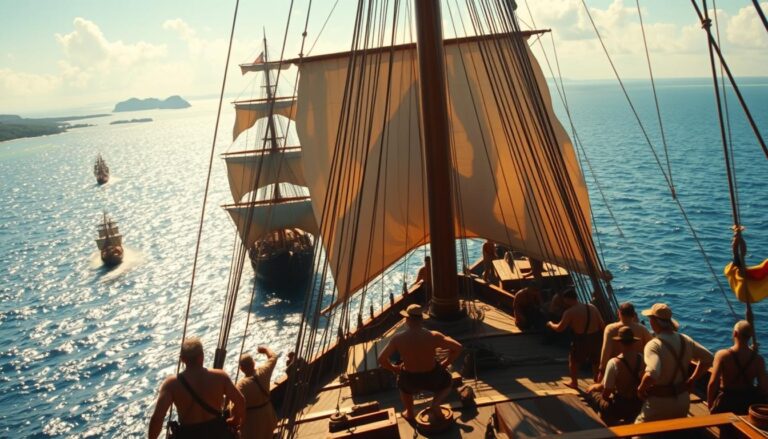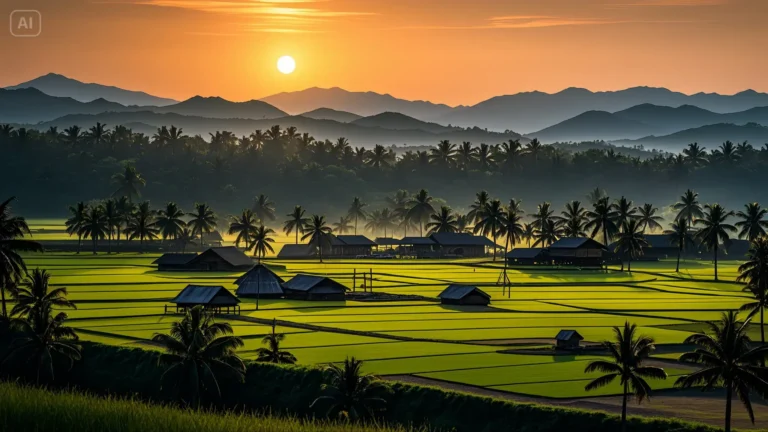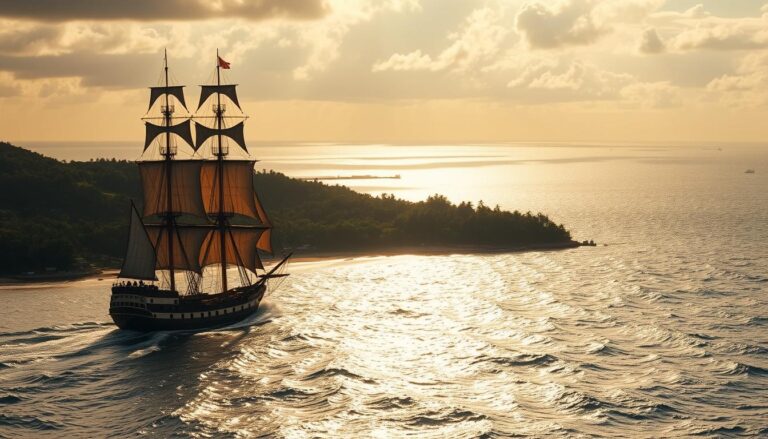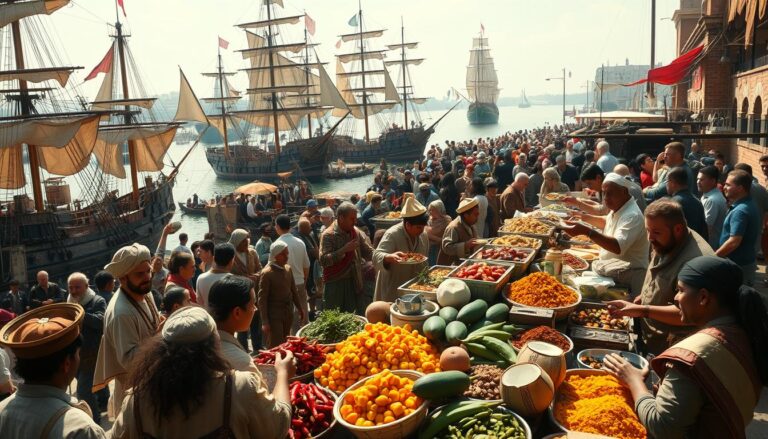Indigenous Filipinos’ Response to the Galleon Economy
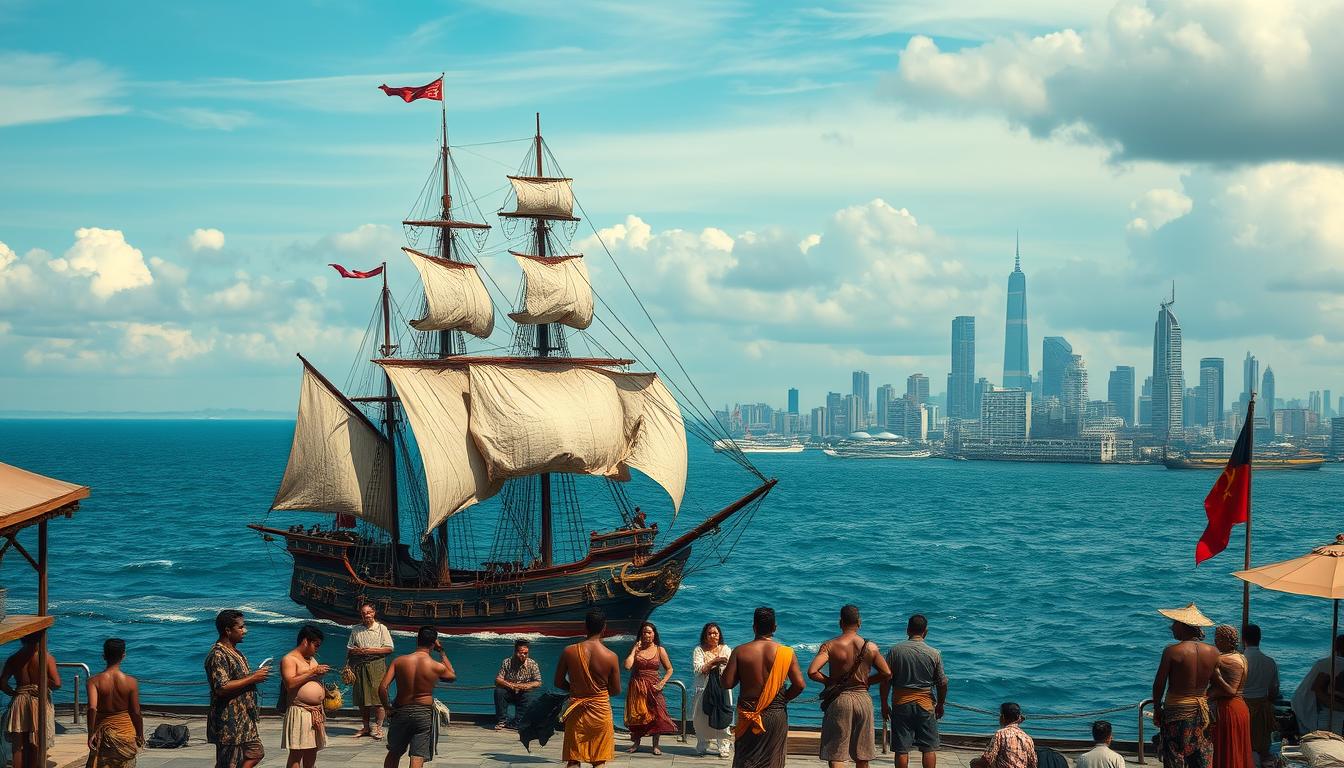
For over 250 years, ships laden with silver and spices sailed between Manila and Acapulco. This galleon trade transformed the Philippine archipelago into a vital link between Asia and the Americas. Coastal villages supplied hardwoods for shipbuilding, while farmers grew surplus crops to feed crews.
The exchange of goods sparked unexpected changes. Chinese merchants introduced iron tools that improved farming yields. Local weavers produced sails from abaca fiber, creating new craft traditions. These innovations helped communities meet demands from distant markets.
Maritime networks brought challenges alongside opportunities. Forced labor systems emerged to maintain the world’s longest shipping route. Villagers faced harsh quotas for food production and construction materials. Yet their craftsmanship built legendary vessels that crossed the Pacific.
Cultural exchanges left lasting marks. Migrants from Luzon settled in Mexico, blending traditions across oceans. Recipes, languages, and beliefs traveled with every cargo hold. This fusion created unique identities that still resonate today.
Key Takeaways
- The Manila-Acapulco trade route operated from 1565 to 1815, connecting three continents
- Local communities provided critical resources like timber, textiles, and agricultural goods
- New farming tools increased crop yields but also led to coercive labor practices
- Cultural exchanges reshaped traditions in both the Philippines and Mexico
- Shipbuilding techniques using native hardwoods became a specialized craft
- The trade route’s legacy is now being considered for UNESCO recognition
Colonial Foundations of the Galleon Economy
Spanish explorers transformed global commerce in 1565 by forging a maritime highway between Asia and the Americas. This bold venture sought to dominate Pacific trade while fueling Spain’s imperial ambitions. At its core lay the Manila galleon trade, a system that reshaped economies for over 250 years.
Inception of the Manila Galleon Trade
Navigator Andrés de Urdaneta cracked the Pacific’s wind patterns in 1565, enabling ships to sail east from the Philippines to Mexico. His discovery of the “Urdaneta Route” let galleons complete round trips between Manila and Acapulco. This breakthrough turned New Spain into a bridge for silver, silk, and spices.
Spanish Influence and Expanding Trade Routes
The Spanish Crown enforced strict control, limiting voyages to two annual galleons. Shipyards in Cavite built vessels using Asian hardwoods and European designs. Merchants funneled Chinese goods through Manila’s port, creating the first global trade loop.
By 1600, the route carried 50 tons of silver yearly to Asia. This wealth funded Spain’s colonies while linking Mexico, the Philippines, and Europe. The galleon network laid groundwork for later colonial systems across the Pacific.
Indigenous Filipinos’ Response to the Galleon Economy
Coastal villages transformed into bustling hubs as the Manila-Acapulco route reshaped daily life. Communities developed specialized roles – some harvested timber for galleon construction, while others perfected abaca rope-making. This division of labor allowed villages to meet Spanish demands while preserving autonomy.
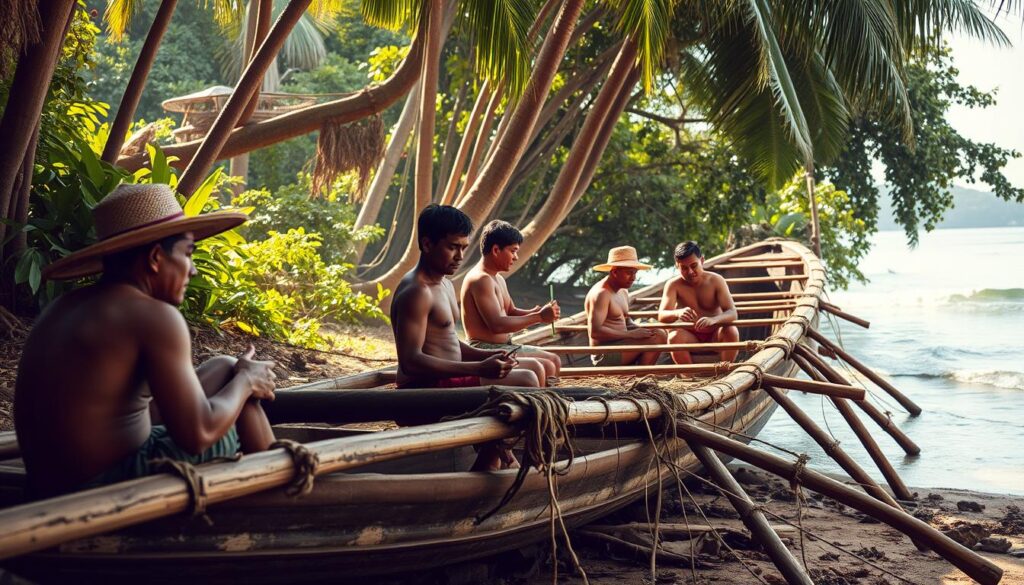
Local leaders turned trade networks into survival tools. A 17th-century account notes: “Timber suppliers negotiated payment in iron tools rather than silver coins”. Farmers adapted by growing quick-harvest crops between monsoon seasons, ensuring food supplies despite forced quotas.
| Adaptation | Impact | Example |
|---|---|---|
| Shipyard labor | New woodworking skills | Molave hardwood shaping |
| Crop rotation | Improved food security | Rice-terrace farming |
| Barter systems | Wealth redistribution | Textiles for metal tools |
Artisans found clever ways to blend traditions with new demands. Weavers incorporated Mexican dye techniques into traditional patterns, creating hybrid textiles prized in both continents. These innovations turned local craftsmanship into global commodities.
Over 250 years, communities built resilience through calculated cooperation. The Boxer Codex reveals how village leaders used Spanish need for quality timber to negotiate better working conditions. This era of adaptation laid foundations for modern Filipino trade practices still visible in port cities today.
Indigenous Resistance and Cultural Adaptation
Local societies navigated colonial demands while protecting ancestral customs. Artisans hid spiritual symbols in church carvings, and farmers maintained harvest rituals despite Spanish oversight. This quiet defiance preserved cultural knowledge across generations.
Preserving Cultural Identity Amid Change
Villages developed covert systems to sustain traditions. Elders taught weaving patterns through song lyrics, embedding history in textiles traded through southeast asian networks. A 17th-century journal notes: “Rice ceremonies continued at moonless nights, disguised as Christian feast preparations”.
Access to ships and foreign goods fueled creative resistance. Metal tools from new spain improved woodcarving, letting craftsmen produce both galleon parts and traditional ancestor figures. Communities bartered surplus crops for dyes to revitalize fading textile arts.
| Resistance Method | Cultural Element | Modern Legacy |
|---|---|---|
| Oral storytelling | Creation myths | Epic poetry festivals |
| Hybrid crafts | Weaving techniques | Pattern patents (2019) |
| Land stewardship | Terrace farming | UNESCO rice terraces |
The manila galleon trade route unexpectedly strengthened regional bonds. Coastal communities shared survival tactics with mountain tribes, creating alliances against resource extraction. Shared wealth from shipbuilding contracts funded hidden schools preserving native scripts.
This era proved cultural practices could adapt without disappearing. When Spanish authorities banned traditional fabrics, weavers incorporated Mexican motifs but kept sacred color combinations. Such innovations allowed traditions to evolve while maintaining core identities.
Filipino Contributions to Maritime Trade and Shipbuilding
Shipyards along Manila Bay hummed with activity as craftsmen shaped Philippine teak into sturdy hulls. These galleons relied on local expertise – from Molave hardwood beams to abaca fiber sails. Communities near Cavite perfected shipbuilding techniques that combined Asian woodworking traditions with European designs.
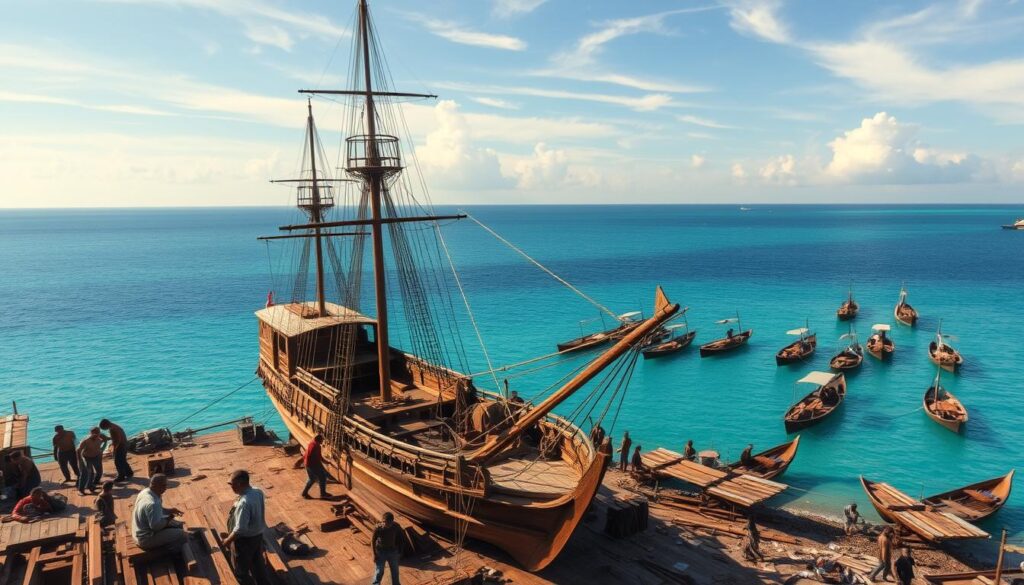
Utilizing Local Materials and Resources
Builders used three key materials:
| Material | Use | Source |
|---|---|---|
| Philippine teak | Hull construction | Luzon forests |
| Manila hemp | Ropes & sails | Abaca plantations |
| Bamboo | Scaffolding | Coastal groves |
Records show Cavite shipyards produced 15 ocean-going vessels between 1609-1616. A Spanish merchant noted: “Their hemp rigging withstands typhoons better than European cordage”.
Role of Filipino Sailors and Labor
Over 80% of crew members came from local communities. Farmers became expert navigators, using starlight patterns to guide ships across the Pacific. Though some laborers were forced into service, many developed valuable skills.
The trade route created specialized jobs:
- Timber specialists curing hardwoods
- Rope-makers twisting abaca fibers
- Cargo masters balancing silver and silk loads
This collaboration between the Spanish Crown and local experts created a unique maritime system. It blended ancestral knowledge with global trade demands, leaving a lasting mark on Philippine craftsmanship.
Socio-Economic Impacts on Indigenous Communities
The galleon network reshaped local economies through competing forces of exploitation and innovation. Coastal populations faced radical shifts as traditional fishing and farming schedules collided with maritime demands. Spanish labor systems like polo y servicios diverted workers to shipyards and cargo routes, disrupting ancestral livelihoods.
Disruptions and Emerging Opportunities
Forced labor quotas left fields untended during planting seasons. A 1593 decree required villages to provide 40 workers monthly for Acapulco dockyards. Yet new skills emerged – rope-makers earned silver pesos, while interpreters gained influence in trade negotiations.
| Challenge | Adaptation | Location |
|---|---|---|
| Labor shortages | Shared farming cooperatives | Central Luzon |
| Tax burdens | Barter networks | Bicol region |
| Crop failures | Salt trading | Ilocos coast |
Overland transport in New Spain created unexpected jobs. Indigenous carriers moved Chinese silks from Acapulco to Mexico City, earning wages that bypassed colonial tax collectors. This underground economy helped communities retain wealth.
Long-Term Community Transformations
By the 18th century, 30% of Cavite households relied on ship-related work. Specialized roles became hereditary trades – families passed down sailmaking techniques for generations. The across pacific exchange also introduced New World crops like maize, diversifying local diets.
These changes forged resilient economic networks that outlasted Spanish rule. Today, port towns still use colonial-era warehouses, while fishing cooperatives trace their structures to galleon-era labor groups.
Transculturation: Culinary and Cultural Exchanges
The Manila galleons did more than transport silver – they carried flavors that reshaped two continents’ kitchens. Ships returning from Acapulco brought Mexican chili peppers, while southeast asian spices traveled west to new spain. This edible exchange created lasting bonds between distant cultures.

Merging of Mexican and Filipino Flavors
Mexican tomatoes transformed Filipino mechado stews, while Philippine mangoes spiced up Mexican salsas. Scholar María BERNAL notes: “Tamales evolved into rice-based goods wrapped in banana leaves instead of corn husks”. This blending turned shared ingredients into distinct regional specialties.
Pineapples became symbols of this fusion. Introduced via the trade route in the 1580s, they thrived in Philippine soil. Farmers soon wove pineapple fibers into delicate piña cloth traded back to Mexico. As MACHUCA’s research shows, this circular exchange enriched both nations’ economies.
Language absorbed these changes too. The Tagalog word kamatis (tomato) comes from Nahuatl tomatl, while Mexicans adopted adobo seasoning techniques. Even religious festivals merged food traditions – Mexican chocolate became part of Filipino Christmas rituals.
Through centuries of exchange, a unique culinary identity emerged. Dishes like pancit noodles and champurrado chocolate drink still reflect this shared history. These flavors endure as tasty proof of the manila galleon trade‘s cultural legacy.
Legacy of the Galleon Economy in Local History
Centuries-old anchors and porcelain shards still surface along Philippine coasts, whispering tales of the galleon route. These artifacts form a physical timeline of the world’s first globalized economy, preserved in museums and coastal villages alike.
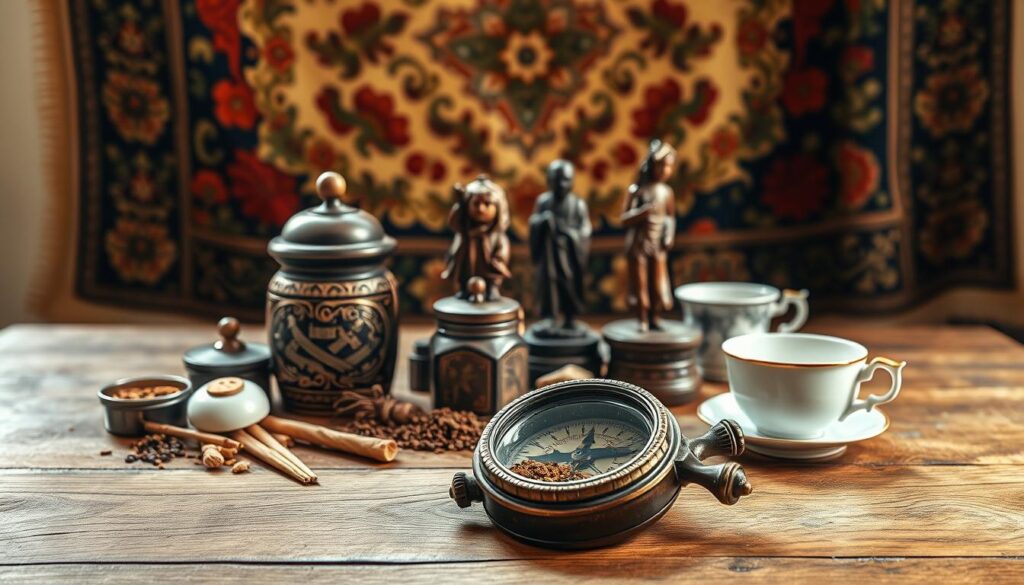
Cultural Memory and Artifact Preservation
Shipwrecks like the Santa Margarita serve as underwater museums. Their cargo holds reveal Mexican silver coins stamped with the Spanish Crown‘s seal alongside Chinese celadon jars. These finds prove how merchants from East Asia to New Spain built interconnected wealth networks.
The port of Acapulco recently unearthed 16th-century ledgers detailing:
“300,000 silver pesos exchanged for 50 tons of cinnamon”. Such records show how the trade system transformed regional economy into global capital hubs.
Modern efforts keep this legacy alive:
- Guampedia’s digital archive preserves Chamorro navigation techniques
- Mexico’s La Nao de China festival reenacts trade route exchanges
- UNESCO considers the Manila galleon trade for World Heritage status
Andrés de Urdaneta’s wind charts remain studied by historians, proving how one navigator’s skill shaped 250 years of transpacific connections. His galleon route blueprint, found in Seville’s archives, continues guiding researchers through this complex trade legacy.
Preserving Maritime Heritage and Indigenous Narratives
Modern efforts to protect maritime legacy are rewriting historical narratives along ancient trade routes. Teams now recover sunken stories through artifacts and oral histories, revealing overlooked contributions from local communities.

Modern Conservation Efforts
The National Museum of the Philippines leads underwater excavations of Manila galleons, partnering with UNESCO and French archaeologist Franck Goddio. Their work preserves 16th-century anchors and cargo manifests that redefine our understanding of Pacific exchange networks.
| Project | Partners | Focus |
|---|---|---|
| Shipwreck Mapping | MUCHD Division | Coastal sites |
| Textile Analysis | Mexico Institute | Trade fabrics |
| Oral History Collection | Local elders | Navigation songs |
Reclaiming Historical Narratives
Exhibits now spotlight merchant ledgers showing barter deals favoring local artisans. “Archaeology proves communities shaped the trade route, not just supplied it,” notes researcher Bobby Orillaneda.
Recent conferences feature descendants of port workers sharing family stories. These accounts challenge colonial-era records, highlighting sustainable practices from the galleon era. International collaborations help reestablish the Philippines’ central role in global trade history.
Conclusion
The transpacific exchange sparked by the Manila-Acapulco route reshaped communities on both sides of the ocean. Over 250 years, this network blended Southeast Asian craftsmanship with New Spain’s resources, creating lasting ties between distant cultures. Shared innovations in shipbuilding and agriculture laid foundations for today’s global economy.
Cultural legacies endure through flavors and traditions. Mexican chili peppers transformed Filipino stews, while Philippine mangoes enriched New World cuisine. These edible connections remind us how everyday exchange shaped national identities across the Pacific.
Preserving port cities and ancestral stories offers lessons for modern dialogue. As UNESCO considers recognizing the Manila galleon’s role, we gain tools to honor diverse contributions to shared history. Protecting these narratives ensures future generations understand how local ingenuity fueled worldwide connections.

